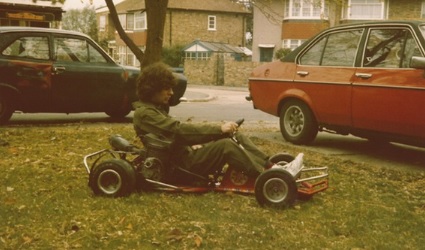Pictures from the recent Curborough and Shelsley HSA rounds. Not much FF progress to report..
The Ford crossflow engine looms large in my family history. We were a Ford family. My Grandfather had a V8 Pilot, later a Cortina and then a Mk1 Escort. My parents had a MK1 Escort, then two Mk2’s. In fact I inherited the Mk1, and used it to tow my kart to meetings.. (see ancient picture below). And all bar the Pilot had the crossflow engine. And it only dawned on me as ordered gaskets for my FF engine that the Kent engine was the crossflow.

Progress on the Rf84 means that fitting the engine is looming large, and therefore I’m having to reacquaint myself with the Dagenham power unit. Some aspects of the engine are obviously familiar. Others less so. Whatever; the plan with the engine is to leave it pretty much alone, or as alone as possible, and use it, as it is, to power my first goes at driving the car. If necessary I’ll get it rebuilt next winter.
Those not in the know may not appreciate that oil pumps come in two types – front mounted and side mounted. The Gatmo engine I’ve got, shown below right, has a front mounted pump, and I’d hoped that was what an RF84 needed. But it turns out that what you need for an 84 Van Diement is a side pump. Which meant changing the pump and a load of other stuff. A continual and almost certainly tiresome aspect of this blog is how much I didn’t know, and the oil system isn’t going to buck that trend.
Luckily when I called Neil Bold (I’d heard his engines were good so I thought that by buying the pump from him he’d be able to help me choose the right one) he told me I needed a five port pump. This piece of information was almost self evident; when I sent him a picture (above left) of the original engine there were obviously 5 ports on the pump. I also sourced a new cam chain cover from Neil. I thought the cam cover might pass over the water pump drive pulley on the end of the crank. Meaning that I’d not have to remove it. But it wouldn’t and I would. Cue deep depression only deepened by watching a series of you-tube videos in which gentlemen called Jed or Earl from the Mid-West of the US remove the pulley nut from engines using rope, or the starter, or a hill and a pickup. OK these did make me laugh, but none got me nearer solving the problem. Only cheering up and thinking like an engineer did that.

I needed to lock the flywheel, and it turns out the internet is awash with flywheel lockers that you can buy. For almost any engine. I’m sure you are ahead of me here; the Kent engine didn’t seem to feature in any list of supported options. If I couldn’t design and make a decent flywheel locker.. well.. I wouldn’t deserve the respect of my peers. As soon as I’d made the locker I had the bolt off the end of the crankshaft without so much as a look at a length of rope, or ride down a hill in a pickup. Moral of the story – get the right tool for the job, and if you can’t, make it. Much better than getting stressed and bodging it.
With the pulley nut removed and the pulley extracted with a puller I removed the pump.
But at this point I started measuring stuff. And it became evident that the engine won’t fit with the current sump. So time for a new sump, I just don’t have the time or equipment to remove the necessary 6mm from the trough.. Hopefully by the time of the next blog I’ll have the engine in.